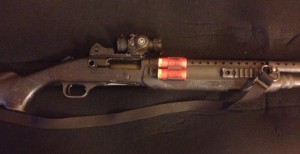Oct. 19-21, Carbine/Submachine Gun User, Spokane County, WA
Oct 22-23, Tactical Pistol, Spokane County, WA
Nov 16-18, Hostage Rescue, Spokane County, WA
Dec 14-16, SWAT Team Leader, Spokane County, WA
Back in March I did a blog post on shotgun breaching for Police SWAT teams. In it I mentioned the need for a full size gun, and a capacity of 8 rounds. I also mentioned that the gun should have a red dot.
I think it’s important to note that shotgun proficiency in LE has been declining for some years. As carbines have replaced shotguns in the squad cars, level of training and attention to the shotgun has waned. The same issues we had years ago still exist, but are exasperated by lack of training. Short stroking the gun is one of those things. To remedy this problem, I recommend that the breaching gun be a semi-automatic. Most SWAT teams are outfitting their guys with good carbines. The breaching gun deserves the same attention AND selection. One of the best I have found for this purpose is the Mossberg 930. Not an expensive gun, but because it is gas operated it will cycle most breaching rounds with ease. I also like the Mossberg safety since I can use it the same way left or right handed. Did I mention it’s inexpensive?
The gun should have a red dot if the breacher has to transition to an anti-personnel role. Officers are comfortable with a red dot on their carbine, I want to make them comfortable with the shotgun. Red dots have become popular because they make people more accurate and faster. The breaching officer should have those benefits as well. I use a Vortex Sparc on my gun, not an expensive red dot by any stretch. It has held zero and continues to chug along at breaching round ranges. I have fired close to 1000 rounds with it and no issues so far. Did I mention it is inexpensive?
Another issue is Tac reloading and speed reloading the gun. THose things need to be practiced and ingrained so that I can plus up the gun quickly after breaching the first door. Another door may pop up in a hurry and I don”t want to run out. I may also shoot the door and have it come open with out a kick. That might put me right into an anit-personnel or Anti-K9 role as well. I need ammo on hand to make this be efficient and quick, a dump pouch or pocket full of loose shells is neither of those things. One of the cheapest and easiest way to carry a crap-ton of rounds is with velcro shell cards. The nice thing is that I can load them up and then just put them in my AR pouches. Since I advocate carrying ONLY the breaching gun for LE, the AR mags are not needed so I can fill those pouches with shell cards. If I empty one on the side of the gun, I just tear it away, pull a fresh one out of the pouch and stick it to the side of the gun. Now my regular gear can support multiple reloads of the shotgun. I use six round cards, but they can be found in 7 or 8 rounds. Examples below are from ESSTAC
Another method for carry is a shell caddy. The one below is the EZ8 shell caddy from Gunnersolution. www.gunnersolution.com. It allows the shooter to easily twin or quad load (Youtube that shit) or load using a more traditional method by pulling from a single row. How much ammo should I be carrying as a shotgun breacher? I have been on missions twice where I went through more than 20 rounds. Large compounds with multiple buildings will eat rounds quickly. I currently carry 8 rounds in the gun, 2 in a stock saddle, and 3, 6 round cards loaded in mag pouches. That’s 28 rounds ready to go .
Last thing is that the shotgun should have the same sling system as the users carbine. I am not a fan of single points or bungee slings. I use a two point sling on my carbine and I use a two point sling on my breaching gun. I wear it as normal but will often just use it as a 12 gauge necklace. I am a left handed long gun shooter, but if the primary entry point makes more sense to run it as a right handed guy, I will typically un-sling for that door and then go back to a necklace or standard sling as I make my way through the target looking for more doors.
Setting dudes up with the proper gear and weapon will usually generate buy in. This means guys will actually practice with it instead of remembering how to use it the day of the mission. You wouldn’t even consider taking a beat up, old ass carbine and making entry with it. Why would you be happy doing that with a breaching gun?


